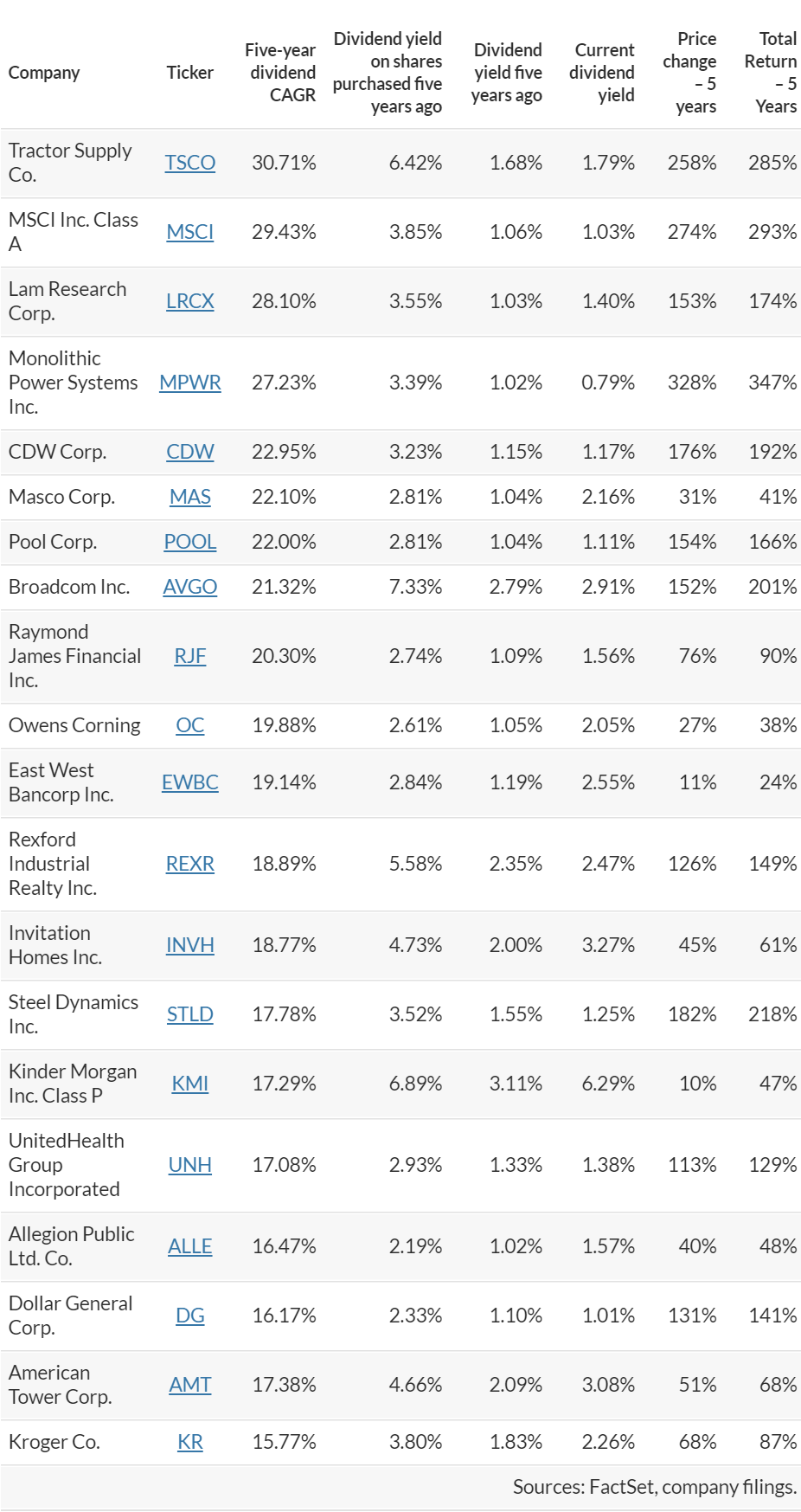Back in January, we took a deep look into three groups of Dividend Aristocrat stocks to show which ones had increased their payouts most significantly over the past five years. Now it is time for a follow-up on other companies that have the potential to earn the Aristocrat distinction.
Before doing this new stock screen, we have to define the Aristocrats:
- The S&P 500 Dividend Aristocrats Index is made up of 65 stocks in the S&P 500SPXof companies that have raised their dividends on common shares for at least 25 consecutive years. That is the only requirement — it makes no difference how high or low the current dividend yield may be. The index is equal-weighted, rebalanced quarterly and reconstituted annually. It is tracked by the ProShares S&P 500 Dividend Aristocrats ETF.The ETF’s total return with dividends reinvested for five years through March 3 has been 62%, slightly better than the 61% return for the ProShares S&P 500 Dividend Trust SPY for the same period. But NOBL is less than 10 years old. If we look at 10-year performance for the indexes, the full S&P 500 has beaten the S&P 500 Dividends Aristocrats Index slightly. Going back 15 years, the S&P 500 Dividends Aristocrats Index has shined, with a 451% return, against 320% for the full S&P 500, according to FactSet.
- The S&P 400 Dividend Aristocrats Index has 50 stocks of companies that have raised dividends for at least 15 consecutive years, drawn from the S&P Mid Cap 400 Index. It is tracked by the ProShares S&P MidCap 400 Dividend Aristocrats ETF.
- The S&P High Yield Dividend Aristocrats Index has 121 stocks drawn from the S&P Composite 1500 Index that have increased dividends for at least 20 straight years. It is tracked by the SPDR S&P Dividend ETF.The S&P Composite 1500 is combination of the S&P 500, the S&P Mid Cap 400 and the S&P 600 Small Cap Index. So the S&P High Yield Dividend Aristocrats Index includes all the stocks in the S&P 500 Dividend Aristocrats Index. But it excludes some that are in the S&P 400 Dividend Aristocrats Index. The name of the High Yield Dividend Aristocrats Index is confusing because the yields aren’t necessarily high — they range from 0.23% to 5.39%.
Altogether there are 139 Dividend Aristocrats.
In January, we listed the 15 Dividend Aristocrats that had been the best income builders over the previous five years.
The concept of building income over the long term is an important one. An investor who is interested in stocks of companies that pay dividends might focus on a high current yield (the annual dividend payout divided by the current share price). But a high current yield might point to a lack of confidence that the company can continue paying a high dividend.
You might benefit from dividend increases over the long term. For an updated example among the S&P 500 Dividend Aristocrats from the previous article, consider Automatic Data Processing Inc.. If you had purchased the stock five years ago, on March 2, 2018 (a Friday), you would have paid $113.60 a share. At that time the annual dividend payout rate was $2.52 a share, for a yield of 2.22%. Fast-forward to March 3, 2023 and the share price had nearly doubled to $224.75. The company now pays $5 a share annually, for a current yield of 2.22% — same as five years earlier. But now the dividend yield on your five-year-old shares is 4.40%.
New screen: potential Dividend Aristocrats
In the comments below the previous Dividend Aristocrats article, a reader had the following suggestion: “Can you run a screen solely on companies that have market caps > $8BN and increased their dividend payouts by 15% or more over the past 7yrs, 5yrs, 3yrs, and 12 months? That would capture some of those companies that aren’t yet Dividend Aristocrats but may be on the way to becoming one. “
To simplify this new screen, we only looked back at five years of dividend growth. And to eliminate distorted dividend growth rates for companies that were making very low payouts five years ago, we set a minimum then-current dividend yield of 1.00%.
For the new screen we began with the S&P 1500 Composite Index and then made the following cuts using data provided by FactSet:
- Remove the 139 companies in all three groups of Dividend Aristocrats to reduce the list to 1,361 companies.
- Remove any company with a current market capitalization less than $8.000 billion: 463 companies.
- Remove any company that doesn’t pay a dividend currently: 339 companies.
- Remove any company that didn’t pay a dividend, or had a then-current dividend yield of less than 1.00%, five years ago: 252 companies.
- Remove any company’s whose annual dividend rate didn’t increase during each of the past five 12-month periods, according to FactSet: 122 companies.
Here are the 20 remaining companies with the highest five-year compound annual growth rates (CAGR) for annual dividends:
Topping the list with the highest five year dividend CAGR is Tractor Supply Co. You can see that the dividend yield five years ago wasn’t very high, at 1.68% and that the current yield for someone buying now would be only 1.79%. But look at how the dividend has grown. If you had held this stock since buying it five years ago, the yield on your five-year-old shares would be 6.42% and your share price would have increased by 258%.
Passing a stock screen guarantees nothing. If you see any companies on the list that interest you, the next step is to do your own research and form your own opinion about each company’s business strategy and how competitive you expect it to be delivering goods and services for the next decade at least.

Comments